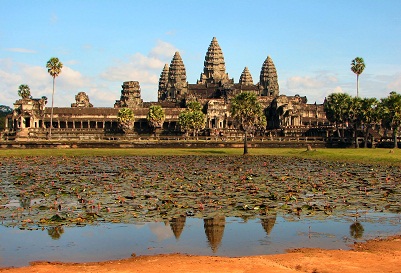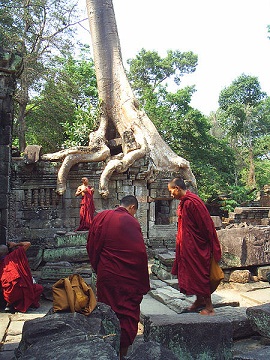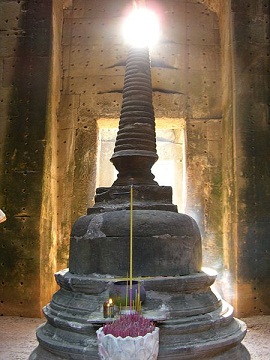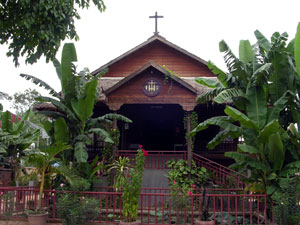
The first time I stepped on the once- sacred grounds of the sprawling (covers an area of almost two hectares), 2,000- year old temple was an overwhelming experience. That was in 1987. I was with a group of journalists of different nationalities covering Southeast Asia. It was a side trip from our main coverage which was an interview in Phnom Penh with Cambodian officials led by Hun Sen, the former Khmer Rouge commander who abandoned the genocidal regime in 1977 and emerged as the leader of the Vietnamese-backed government. He is currently the prime minister of the Kingdom of Cambodia.
Last week, I went back to Siem Reap with my friend, Marilyn Robles. For three days, we went temple-hopping – total of 23 temples in three days. In the process of being enthralled by the distinct features of each temple, we met interesting persons.
One was Muk Moon, former monk and a resident of Angkor Wat.
He approached us as we were about to enter the main gate of Angkor Wat, asking if we needed a guide. “This is my hotel,” he said to underscore his familiarity with the place.
Indeed, he knows Angkor Wat like the palm of his hands.From the information he shared including his views about life, once can sense his innate intelligence.

He was born in the year (1975) that the Pol Pot-lead Democratic of Kampuchea started implementing their experimental “socialism without a model.”
Cambodia expert,David Chandler, said in his , “A history of Cambodia”, “To transform the country thoroughly and at once, Communist cadres ordered everyone out of the cities and towms. In the week after April 17, 1975, over two million Cambodians were pushed into the countryside toward an uncertain fate…”
News accounts put the number of those who died of famine, disease, and torture during the Khmer Rouge short-lived regime to two to three million.
Moon said at age 14, he was recruited by the Vietnamese-backed Cambodia Army to fight the Khmer Rouge.
He didn’t like the war, he said. He left the military and joined the monks.
He is no longer a monk but he continues to live with the monks, who have their living quarters in Angkor Wat. Some days, he said, he spends the night in one of the many rooms in the temple.
He exudes an air of serenity. Although there are things that he laments about life in Siem Reap (the loss of huge part of the forests), he has learned to accept things as they are. “Big talking, big smiling,” he said of his life, the same description he used to describe Heaven symbolized by the northern Library on the side of the grand causeway leading to the main gate.

We noticed a lot of uniformly-spaced holes, about one inch in size, on the walls of some rooms of the temple. So explained that diamonds were once embedded on those walls as décor. Thieves, known as tomb raiders, took them out.
Just like Moon, So also called our attention to the headless Buddhas – the handiwork of tomb raiders.Parts of figures from Cambodian temples are worth tens and thousands of dollars in the antiquities blackmarket.
Preah Khan has four medicine rooms. (Angkor Wat has one). Moon explained that the room is where the medicine man performs a ritual to cure those who consult him. To test if a person is well, he is made to stand against the wall, and is made to tap his chest three times. While doing that, if one is healthy, he would be able to feel and hear the echo of the breast-tapping.
Like Ta Prohm,location of the Angelina Jolie movie “Lara Croft:Tomb Raider”, Preah Khan has centuries old trees grappling the stone structures. It’s an awesome sight.

Fr. Winarto said he has a lot of Filipino parishioners. The church has a gift shop with items produced by victims of land mines. Their Jesus Christ has one leg.
One remarkable thing about Siem Reap: You don’t see any sign warning tourists about pickpockets because there are none.
That’s one of the things Filipinos should learn from Siem Reap.
Wow, walang pickpockets!
No wonder Angelina Jolie is so in love with the place, ang ganda-ganda!
Thanks, Ellen, tutuwid na daan ako dyan galing Cebu when I visit Pinas.
Sorry, I have no photos of Muk Moon and So Rith. I didn’t have a camera. It was Marlyn who took photos. But she is so busy now. She will be able to organize her photos later.
Siem Reap’s peace and order situation is definitely a lot better than Manila’s. But just like any other society, there are bad elements. There have been some incidents of theft in hotels.
I read one tourist advisory to be careful about buying gems.
A tourism officer told us about a Filipino businessman (he owns a restaurant chain) who bought $28,000 (28,000 dollars!!!)worth of diamonds which turned out to be fake. He returned to Siem Reap and complained to police authorities. He was able to recover his money.
For a successful businessman, he was not being wise in buying that much “diamonds” without the help of an expert.
I remember in 1993, on a coverage in Phnom Penh, we went to the market and saw semi-precious stones (emerald,jade,rubies etc.) being sold cheap. Hindi naman kasi ako mahilig sa alahas.
You also see a lot of disabled people, without leg or arms – victims of landmines. Kawawa sila. Cambodians have suffered a lot.
I would like to visit these places one day too.
Ellen, ruins na ba sa loob o buo pa rin?
“The church has a gift shop”. Quick! Hide or darken this phrase, you’re giving the Noypi Bishops an idea to make more money.
Just read today, Dallas Cowboys Stadium (NFL), now have Victoria’s Secret in their Gift Shop, good idea….will make more professional football players become perverts, wink!
Chi, different temples are in different conditions.There are some that have collapsed walls and have not yet been restored. Others like the Angkor Wat has been restored. A number of them, they have been purposely left in a state they have been discovered like Preah Khan, where the roots of the tree are gripping the structure.
Considering that the temples are almost 2,000 years old, they are well preserved. I am in awe of the architectural and masonry skills of the Cambodian builders.
You will love Siem Reap, Chi. Just make sure you are fit and healthy with all the walking and the climbing that you have to do.
You will be going there from Manila? Sana sama tayo nina Anne.
Thanks, Ellen. Super ganda pala visualization ko pa lang.
Yes, from Manila if my dream of next Pinas visit will materialize. Saya-saya natin nina Anne pagnagkataon.
hi Chi…Ellen…
yes Siem Reap is a good place to go for a respite. Quiet and people are simple as well. taking the Tuk-tuk is also a good one especially if you find one who you will feel at ease with. our tuk-tuk driver(s) are honest to tell us when taking which tour and what to expct. true enough, we were adviced truthfully. better be in good comfy shoes, comfy clothes and no brick-bracks that are not important. the best things to bring along, fully charged camera, bottle of water jug if you can manage, sun visor or hat and sunglasses if not into sunbathing stuff, small bills (if you suddenly feel being generous), and most of all smiles and open mind and heart to welcome peace.